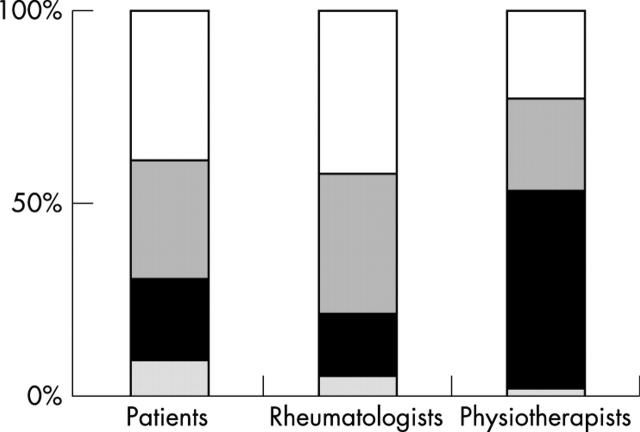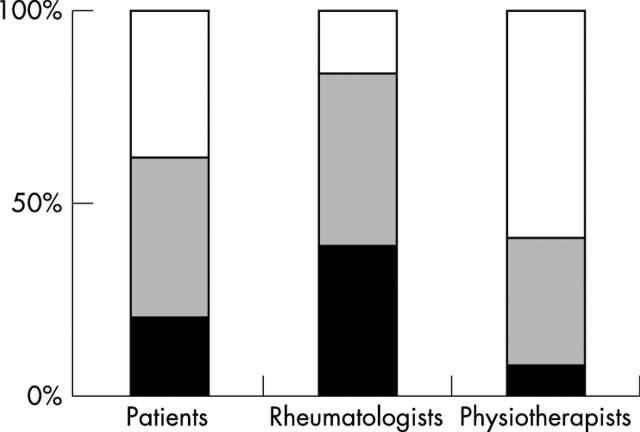Abstract
Objective: To examine the outcome expectations of RA patients, rheumatologists, and physiotherapists regarding high intensity exercise programmes compared with conventional exercise programmes.
Methods: An exercise outcome expectations questionnaire was administered to 807 RA patients, 153 rheumatologists, and 624 physiotherapists. The questionnaire consisted of four statements regarding positive and negative outcomes of high intensity exercise programmes and four similar statements for conventional exercise programmes. A total expectation score for both conventional and high intensity exercise was calculated, ranging from –2 (very negative expectation) to 2 (very positive expectation).
Results: The questionnaire was returned by 662 RA patients (82%), 132 rheumatologists (86%), and 467 physiotherapists (75%). The mean (95% confidence interval) scores for high intensity exercise programmes were 0.30 (0.25 to 0.34), 0.68 (0.62 to 0.74), and –0.06 (–0.15 to 0.02), and for conventional exercise programmes were 0.99 (0.96 to 1.02), 1.13 (1.09 to 1.17), and 1.27 (1.21 to 1.34) for RA patients, rheumatologists, and physiotherapists, respectively. In all three respondent groups, the outcome expectations of high intensity exercise were significantly less positive than those of conventional exercise programme.
Conclusions: Despite the existing evidence regarding the effectiveness and safety of high intensity exercise programmes, RA patients, rheumatologists, and physiotherapists have more positive expectations of conventional exercise programmes than of high intensity exercise programmes. Physiotherapists were the least positive about outcomes of high intensity exercise programmes while rheumatologists were the most positive. To help the implementation of new insights in the effectiveness of physical therapy modalities in rheumatology, the need for continuous education of patients, rheumatologists and physiotherapists is emphasised.
Full Text
The Full Text of this article is available as a PDF (95.6 KB).
Figure 1.
Results of the exercise outcome expectations questionnaire (mean (95% confidence intervals)). Exercise belief scores are presented for conventional and high intensity exercise programmes. Scores can range from –2 (very negative expectation) to 2 (very positive expectation). *All differences between patients (n = 606), rheumatologists (n = 122), and physiotherapists (n = 119) are statistically significant with one exception for the difference between patients and rheumatologists concerning their expectations about conventional exercise.
Figure 2.
Proportions of patients, rheumatologists, and physiotherapists believing that high intensity exercise is attainable for no or a few RA patients (black bands), about half of all RA patients (upper grey bands), and for many or all RA patients (white bands). The proportion of respondents without an opinion is shown by the lower grey bands.
Figure 3.
Percentages of patients, rheumatologists, and physiotherapist agreeing with the statements high intensity exercise is better than conventional exercise (black bands), is as good as conventional exercise (light grey bands) and conventional exercise is better than high intensity exercise (white bands).
Selected References
These references are in PubMed. This may not be the complete list of references from this article.
- Gecht M. R., Connell K. J., Sinacore J. M., Prohaska T. R. A survey of exercise beliefs and exercise habits among people with arthritis. Arthritis Care Res. 1996 Apr;9(2):82–88. doi: 10.1002/1529-0131(199604)9:2<82::aid-anr1790090203>3.0.co;2-t. [DOI] [PubMed] [Google Scholar]
- Häkkinen A., Sokka T., Kotaniemi A., Hannonen P. A randomized two-year study of the effects of dynamic strength training on muscle strength, disease activity, functional capacity, and bone mineral density in early rheumatoid arthritis. Arthritis Rheum. 2001 Mar;44(3):515–522. doi: 10.1002/1529-0131(200103)44:3<515::AID-ANR98>3.0.CO;2-5. [DOI] [PubMed] [Google Scholar]
- Iversen M. D., Fossel A. H., Daltroy L. H. Rheumatologist-patient communication about exercise and physical therapy in the management of rheumatoid arthritis. Arthritis Care Res. 1999 Jun;12(3):180–192. doi: 10.1002/1529-0131(199906)12:3<180::aid-art5>3.0.co;2-#. [DOI] [PubMed] [Google Scholar]
- Jensen G. M., Lorish C. D. Promoting patient cooperation with exercise programs: linking research, theory, and practice. Arthritis Care Res. 1994 Dec;7(4):181–189. doi: 10.1002/art.1790070405. [DOI] [PubMed] [Google Scholar]
- Minor M. A., Lane N. E. Recreational exercise in arthritis. Rheum Dis Clin North Am. 1996 Aug;22(3):563–577. doi: 10.1016/s0889-857x(05)70288-x. [DOI] [PubMed] [Google Scholar]
- Munneke Marten, de Jong Zuzana, Zwinderman Aeilko H., Jansen Annemarie, Ronday H. Karel, Peter Wilfred F. H., Boonman Dies C. G., van den Ende Cornelia H. M., Vliet Vlieland Theodora P. M., Hazes Johanna M. W. Adherence and satisfaction of rheumatoid arthritis patients with a long-term intensive dynamic exercise program (RAPIT program). Arthritis Rheum. 2003 Oct 15;49(5):665–672. doi: 10.1002/art.11382. [DOI] [PubMed] [Google Scholar]
- Neuberger G. B., Kasal S., Smith K. V., Hassanein R., DeViney S. Determinants of exercise and aerobic fitness in outpatients with arthritis. Nurs Res. 1994 Jan-Feb;43(1):11–17. [PubMed] [Google Scholar]
- Robison J. I., Rogers M. A. Adherence to exercise programmes. Recommendations. Sports Med. 1994 Jan;17(1):39–52. doi: 10.2165/00007256-199417010-00004. [DOI] [PubMed] [Google Scholar]
- Scott D. L., Wolman R. L. Rest or exercise in inflammatory arthritis? 1992 Oct 21-Nov 3Br J Hosp Med. 48(8):445–447. [PubMed] [Google Scholar]
- Siegert C. E., Vleming L. J., Vandenbroucke J. P., Cats A. Measurement of disability in Dutch rheumatoid arthritis patients. Clin Rheumatol. 1984 Sep;3(3):305–309. doi: 10.1007/BF02032335. [DOI] [PubMed] [Google Scholar]
- Stenström C. H., Arge B., Sundbom A. Home exercise and compliance in inflammatory rheumatic diseases--a prospective clinical trial. J Rheumatol. 1997 Mar;24(3):470–476. [PubMed] [Google Scholar]
- Stenström C. H. Radiologically observed progression of joint destruction and its relationship with demographic factors, disease severity, and exercise frequency in patients with rheumatoid arthritis. Phys Ther. 1994 Jan;74(1):32–39. doi: 10.1093/ptj/74.1.32. [DOI] [PubMed] [Google Scholar]
- Van den Ende C. H., Vliet Vlieland T. P., Munneke M., Hazes J. M. Dynamic exercise therapy in rheumatoid arthritis: a systematic review. Br J Rheumatol. 1998 Jun;37(6):677–687. doi: 10.1093/rheumatology/37.6.677. [DOI] [PubMed] [Google Scholar]
- Westby M. D. A health professional's guide to exercise prescription for people with arthritis: a review of aerobic fitness activities. Arthritis Rheum. 2001 Dec;45(6):501–511. doi: 10.1002/1529-0131(200112)45:6<501::aid-art375>3.0.co;2-y. [DOI] [PubMed] [Google Scholar]
- van den Ende C. H., Breedveld F. C., le Cessie S., Dijkmans B. A., de Mug A. W., Hazes J. M. Effect of intensive exercise on patients with active rheumatoid arthritis: a randomised clinical trial. Ann Rheum Dis. 2000 Aug;59(8):615–621. doi: 10.1136/ard.59.8.615. [DOI] [PMC free article] [PubMed] [Google Scholar]
- van den Ende C. H., Hazes J. M., le Cessie S., Mulder W. J., Belfor D. G., Breedveld F. C., Dijkmans B. A. Comparison of high and low intensity training in well controlled rheumatoid arthritis. Results of a randomised clinical trial. Ann Rheum Dis. 1996 Nov;55(11):798–805. doi: 10.1136/ard.55.11.798. [DOI] [PMC free article] [PubMed] [Google Scholar]





